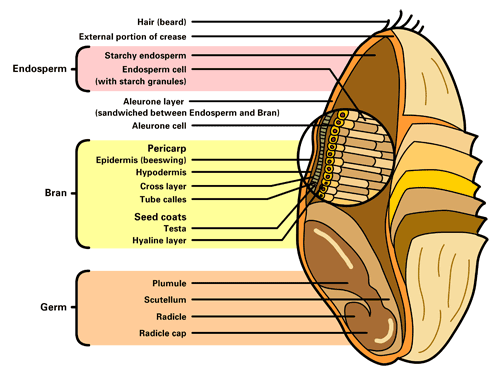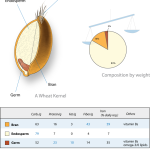With the rise in so many people being diagnosed as “Gluten Intolerant” or having a “Gluten Sensitive” it’s no wonder that this naturally occurring protein has gotten an undeserved bad name. Unless the diagnosis is actually “Celiac’s Disease” – you may just be one of the numerous people who are affected by our highly processed flour and diet and may not actually suffer from a true intolerance or sensitivity to gluten. I truly believe, and can attest to it personally for myself, that it is not gluten that is the problem for most people. It is the processing of flour to make it so-called “shelf worthy” that is a big problem.
The truth is that gluten is present in many grains, mostly however, wheat is the most widely used and recognized. Gluten was not ever meant to be consumed without the benefits of the entire grain – which you cannot get in a bag of dead store bough flour…even ‘whole’ wheat flour. Mostly because it isn’t the whole wheat kernel…although it may be allowed to labeled that way.
 The wheat grain was created to work like all whole foods – with a synergistic relationship one part to another, with each part in tact. When a wheat grain is stripped down to make white flour all but the endosperm is discarded and we are left with the white flour that can hold together a paper mache’ creations – of course then gluten becomes an issue – where are the parts that help us to digest this ‘glue’? They are missing. Even in ‘whole wheat’ flour the wheat germ oil mostly is removed to prolong shelf life. Traces of it are left and the rancidity of the traces of oil is what cause the bitter taste in bagged ‘whole wheat’ flour. No wonder no one seems to think they can like whole wheat – they taste the rancid oil left in the bagged dead flour.
The wheat grain was created to work like all whole foods – with a synergistic relationship one part to another, with each part in tact. When a wheat grain is stripped down to make white flour all but the endosperm is discarded and we are left with the white flour that can hold together a paper mache’ creations – of course then gluten becomes an issue – where are the parts that help us to digest this ‘glue’? They are missing. Even in ‘whole wheat’ flour the wheat germ oil mostly is removed to prolong shelf life. Traces of it are left and the rancidity of the traces of oil is what cause the bitter taste in bagged ‘whole wheat’ flour. No wonder no one seems to think they can like whole wheat – they taste the rancid oil left in the bagged dead flour.
So there are two problems – just to name a a few that help to feed (no pun intended) this frenzy of gluten being a problem. It in fact is a fraction of a whole that was meant to work together in our digestive system.
Now let us just take a quick look at what is missing nutritionally when we consume only the white dead bagged flour.
It’s called ‘enriched’ flour for a reason. It has been ‘enriched’ with synthetic (yes, think – fake) vitamins and minerals to attempt to replace what has been removed when the other parts of the kernel have been omitted from your flour. 
This small diagram to the right (if you click it – it enlarges) shows what is missing when only the white flour is consumed. The lack of vital nutrients in the wheat flour that we consume is creating gluten sensitivities and intolerance – not the gluten itself. Gluten itself may not be the problem.
The bran contains more protein than the endosperm, trace oils (good oils too – natural vitamin E ) a very high percentage of one’s daily allowance of fiber and iron. Not to mention the B vitamins vital for energy in our bodies.
The germ is the powerhouse for the kernel that helps it grown into a live plant – and our commercialized process strips it from us. Highest in protein, it also contains the vital oils with their vitamin E and lipids and omega oils that we seem content to pay extra for in supplements. Iron and B vitamins are also very high in the wheat germ.
We are a people who are satiated, yet extremely malnourished.
Below are some personal stories about my journey to discover the real problem for me and I suspect for many who may be under the assumption they have a gluten problem. Please listen and watch to gain more information than is not included in this post.
You can listen to my story below and see the path that I personally took to prove that gluten was not the problem for me:
New Family Internet Radio with Millers Grain House on BlogTalkRadio
This video was one of my first on our YouTube Channel.
80+ videos later it still is one of my favorites for educating people about the benefits of home-milling.
I hope you enjoy…
6 Responses to Gluten may not be your problem.
Leave a Reply



I so agree with your findings! Thank you for writing this….I have several friends that need to read this! I will be passing it on to them!
Thank you! I love how easy and simple you made this and it was very clear! WOW.
I have milled and baked my own bread but haven’t done so recently. I need to get back to doing it. Shame on me. Thank you for the “reality” check. I hope to learn more about using other grains.
I agree that highly processed grains are very detrimental to our health. Something that I would like to add to the conversation is that it’s very important to avoid grains that are not organically grown. One of the things that is done to grains such as wheat and rye in conventional agriculture is to “dry down” the grains with roundup and other glyphosate-containing herbicides. Roundup is extremely toxic to human, animal and soil health and is a patented antibiotic and mineral chelator that wreaks havoc on the human digestive system with such maladies as leaky gut, crohn’s disease, and other digestive disorders. The worst part about it is that since Roundup is a systemic herbicide, it cannot be washed off of the grains!
The problem is Monsanto has changed the seed in many grains to make it produce better but now our bodies can not recognize the grain and doesn’t know how to process it. That is why so many strange disorders have came up and now there is an explosion of people, not necessarily kids but adults who are suddenly very allergic to wheat/gluten. I and many others I know can’t go out without packing benidryl and Epipens with us. But I had a friend who went to Hungary last year that is just as allergic as I am and kept looking at all those lovely pastries they make over there and just had to try one knowing she’d be spending a night in the hospital afterwards. She ate and got ready for the reaction but it never came. The reason is those old countries over there prevent manipulated grains from ever entering their countries. They are still growing, harvesting, eating and using as seed the same ancient grains they’ve always used. They can say what they want to say but it is a fact. What Monsanto has done to our grains can not be properly digested by the human body and it has poisoned the soil it is grown in. Any other grain grown in the same soil picks up the same gene and is carried on and the seed can not be used to grow new crops. The first year will produce a crop but none will produce afterwards. It isn’t just gluten but also corn and soy beans and rice that has been manipulated. If you start having problems with gluten you will also have problems with either corn or soy beans or even both.
Good comments all!
I only buy non-gmo organic (or chemical free) grains. Since organically grown grains can be gmo and non-gmo can be grown with pesticides it’s important to cover BOTH bases when buying grain. That’s why we offer non-gmo organically grown grains.
The grain, when used as a whole, is created to have the parts needed to digest the other parts. They work synergisticly to process in the body.
Agreed, if poor digestion is an issue, soaking (which is a predigesting process) can help.
Often gluten all together has been labeled as ‘bad’ and that is simply not the case for everyone.
This is becoming more and more complicated and really has become a serious food crisis for a lot of us. Thank you for the information that you provide. It is so good that we have people/suppliers that we can trust. It is just a matter of getting adjusted to a new manner of shopping and budget adjusting. It probably is a matter of spending money now for good food that we can trust or spending it later in medical costs and loss of productivity, but it does take some adjustment of the budget. I am just so glad that alternatives and good information are available. Thanks